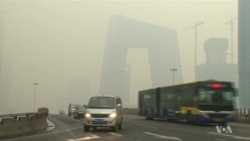Schoolchildren in Beijing stayed home and commuters exchanged their cars for public transportation as the Chinese capital's first-ever red alert for pollution took effect.
Residents wore protective masks as they walked through the thick haze of gray smog that shrouded Beijing's skyline.
"I have been in Beijing for 20 years now, and before, it did not use to be like this. Before, there were only a few cars on the road but now, look, there are more and more. There are many reasons for this pollution,” said Beijing resident He Xiubao.
Beijing authorities issued the red-alert Monday after readings showed levels of dangerous microscopic particles called PM2.5 well above the 25 micrograms per cubic meter recommended by the World Health Organization.
“You have to do whatever you can to protect yourself,” Beijing resident Li Huiwen said while stopping at a market. “Even when wearing the mask, I feel uncomfortable and don't have any energy.”
Under the red-alert, schools are closed, vehicles will only be allowed on the roads on alternate days, depending on the last number of the car's license plate, and all outdoor construction has been ordered to stop. The alert ends Thursday, when cold temperatures are expected to reduce smog levels.
Authorities are under fire for failing to issue a red-alert last week when Beijing was also covered by dangerous smog.
An online notice from the Beijing Municipal Environmental Protection Bureau on Monday said it issued the alert to “protect public health and reduce levels of heavy air pollution.”
Beijing hotel staffer Fan Jinglong said the smog forecast was “really worrisome.”
“We have no choice but to step up preventative measures like wearing a mask outdoors at all times,” he said.
Readings of PM2.5 particles climbed toward 300 micrograms per cubic meter on Tuesday and are expected to continue rising before the air begins to improve with the arrival of a cold front on Thursday. The World Health Organization designates the safe level for the tiny, poisonous particles at 25.
Along with limiting cars to driving every other day depending on the last number of their license plate, a raft of other restrictions will seek to reduce the amount of dust and other particulate matter in the city of 22.5 million people. Officials said extra subway trains and buses would be added to handle the additional strain on public transport.
It's the second time this month that notoriously polluted Beijing has experienced a prolonged bout of smog, sending PM2.5 levels in the suburbs as high as 976 micrograms. Beijing was also shrouded in persistent smog for most of November, when power demand soared due to unusually cold weather.
While pollution in the capital improved in the first 10 months of the year compared with the same period last year, heavy smog that can be seen from outer space regularly forces Beijing schools to suspend outdoor activities and can even prompt highway closures because of reduced visibility.
“It is a sharp warning to us that we may have too much development at the price of environment and it is time for us to seriously deal with air pollution,” said Fan, the hotel employee.
There previously have been stretches of severe smog in Beijing that lasted more than three days. However, those had initially been forecast to last three days or less, so they did not trigger a red alert. The alert requires a forecast of more than 72 straight hours with PM2.5 levels of 200 micrograms per cubic meter or more.
Polluted air throughout broad swaths of China has had severe health effects. A study led by atmospheric chemist Jos Lelieveld of Germany's Max Planck Institute and published this year in Nature magazine estimated that 1.4 million people each year die prematurely because of pollution in China.
China is one of the world's biggest emitters of greenhouse gasses, due to numerous coal-fired plants that have fueled the country's rise as a global economic superpower. The red-alert comes as global climate talks continue in Paris. The Chinese government has vowed to reduce greenhouse gas emissions.
Some material for this report came from AP.










